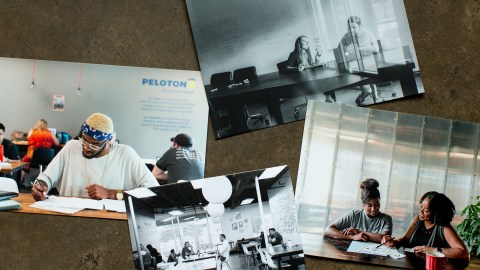Higher ed wasn’t built for today’s student. Let’s not go back to business as usual.

Image: Courtesy of PelotonU
- Across the US, only half of those who start college ever graduate—and that’s before you disaggregate for race or class. That means 45 million Americans adults have tried college and not yet earned a degree.
- The reason is simple: College wasn’t built for today’s student, a majority of whom are over the age of 24, are working 30+ hours per week, or have children.
- PelotonU, a hybrid college in Austin, TX, has redesigned the college experience to ensure it works for all of today’s students, especially in a pandemic. Its co-founder, Sarah Saxton-Frump, is urging other colleges not to go back to business as usual post-COVID-19.
For a moment, imagine it’s pre-COVID. You don’t have a bachelor’s degree, and you decide you need to go back to school—for a pay raise, or a career change, or personal fulfillment. But nothing else in your life can change; you still have to work 40 hours a week, raise kids, pay your mortgage.
Could you have made that work? And would it be worth the sacrifice?
What about now, during a global health crisis when in-person learning isn’t available, you’re an essential worker, and your kids are sharing the family laptop to study at home? For most people, the answers are “probably not.”
We’ve known higher ed was broken for a while; employers aren’t sure graduates have the right skills, and you can’t read the news without hearing about over $1 trillion in student loan debt. More than these problems, though, there’s been a deeper issue, a structural one.
Nationwide, only half of those who start college ever graduate—and that’s before you disaggregate for race or class. That means 45 million Americans adults have tried college and not yet earned a degree.
And the reason is simple: College wasn’t built for today’s student.

Photo: Courtesy of PelotonU
Seventy-four percent of students are now post-traditional, which means they are older than 24, working 30+ hours per week, commuting to school, attending part-time, or caring for a kid. Their graduation rates rarely top 20%—and, in fact, most colleges only report on first-time, full-time students, so under-reporting is rampant. This has led to a fundamental mismatch between the needs of today’s students and the design of higher education. A post-traditional student’s complex life doesn’t fit within the rigid structure of traditional higher education.
At PelotonU, a hybrid college in Austin, TX, we redesigned the college experience to ensure it works for all of today’s students, especially in a pandemic. That means college becomes both flexible and supportive, a balance we strike by combining the very best of online education with the best of the in-person experience.
Our university partners offer rigorous, project-based, affordable degree programs that are competency based. This allows all learners to thrive within a pedagogical approach that values mastery of skills over seat time and strict deadlines. It also allows classwork to fit around the students’ schedule, so when work shifts change or childcare falls through, these important responsibilities don’t cause them to drop out.
74% percent of students are now post-traditional, which means they are older than 24, working 30+ hours per week, commuting to school, attending part-time, or caring for a kid. Their graduation rates rarely top 20%—and, in fact, most colleges only report on first-time, full-time students, so under-reporting is rampant.
By themselves, though, these high-quality university programs aren’t quite sufficient for student success.
That’s why we leverage the 3 best parts of the in-person experience to ensure our students graduate: community, care and coaching.
- Community. We create community through in-person study spaces that are open nights and weekends so students have a sacred space to focus on school without the demands of home or work to distract them.
- Care. We partner with local organizations to support our students in areas where we don’t have expertise, in everything from complex FAFSA applications to licensed mental health support; we also provide scholarships and technology ourselves.
- Coaching. Every student is paired with an expert, trained coaching staff member who meets with them weekly to provide personalized, face-to-face guidance around the emotional, logistical and academic obstacles to their degree.
Through our blend of competency-based degree programs and in-person coaching, community, and care, we see 80% of our students graduate, which is five times the rate of their peers.
In the era of COVID-19, however, we’ve had to innovate in ways we wouldn’t have considered otherwise. Though our university partners are online, all of our support has historically been in person. As we’ve shifted to remote support, we’ve known it’s not enough to just take what we do in person and stick it online.
We need to redesign that support from the ground up, as if we always intended to provide our coaching, community and care online. It’s worked, better than we expected, and we’re already seeing excellent results. Most students are able to continue their studies or take breaks within a semester rather than drop out; students report feeling deeply supported both personally and academically, and we’ve seen very promising results for our first group of all-virtual students: they’re exceeding our usual success rates by 14%.
Rather than simply taking the traditional structure of credit hours and semesters, midterms and final papers and digitizing them, universities can design from first principles on how teaching and learning really occur for their students. They can reimagine the role of the professor, the power of a seminar discussion, and the function that deadlines plays in learning. In unstable times, learning can still happen but it needs to be on the students’ terms to decide when and how much they can handle. If universities can redesign for flexibility and rigor in a virtual environment, they’ll not only transform how well they can serve students but also prepare themselves to weather the uncertain future.

These are the college students of today. Let’s redesign higher education for them.Photos: Courtesy of PelotonU





